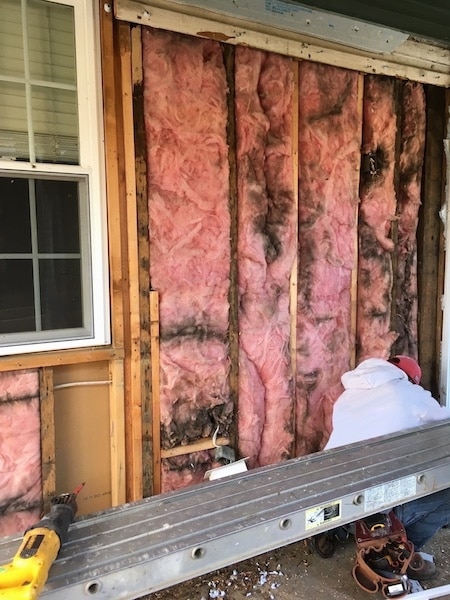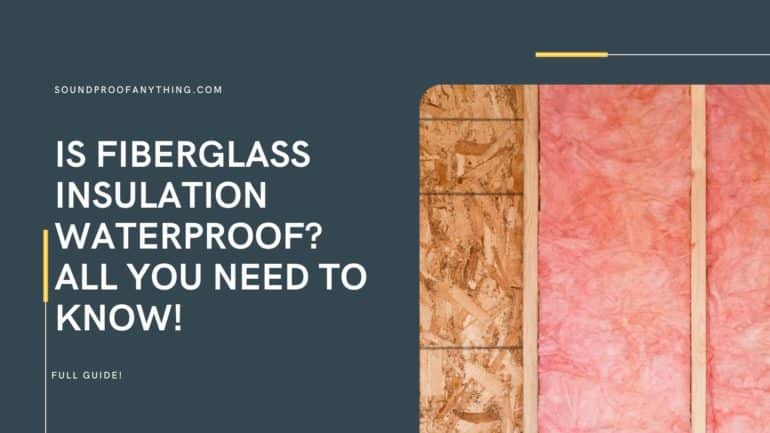Fiberglass insulation is probably the most commonly used material for insulating homes and buildings, be it for thermal or acoustic insulation. But it’s also extremely important to take into account how this insulation material behaves when exposed to water, mainly if it gets wet, if this might ruin it, if it’s still as effective while wet, and what the long-term implications of moisture exposure are to fiberglass insulation, and more.
In this article, I will be going over the different characteristics of Fiberglass insulation, if it’s waterproof or not, what moisture does to it, if you can simply let it dry or if it’s ruined once wet, etc, and I will also compare it to other similar materials such as Rockwool, Spray foam, Cellulose, etc., and a lot more.
So, without any further ado, let’s get started!
Table of Contents
Is Fiberglass Insulation Waterproof?
Fiberglass insulation is not waterproof since it’s water permeable, even if it comes with the adhesive aluminum backing which serves as a vapor barrier. So, you cannot use it in foundations or other areas where excessive exposure to moisture is an issue.
Although I will go into much more detail in the coming sections, it’s worth mentioning that fiberglass insulation, or glass wool insulation, won’t be harmed by getting wet temporarily and that letting it dry out completely will restore all of its insulation capabilities, be it thermal or acoustic insulation.
What is Fiberglass?

Fiberglass insulation, or properly named glass wool (fiberglass is actually the one used for boats, etc., which is rigid), is an insulation material made from fibers of glass arranged into a texture similar to wool.
The process traps many small pockets of air between the glass, and these small air pockets result in high thermal and acoustical insulation properties.
Glass wool generally comes in the form of rolls or in slabs, with different thermal and mechanical properties, but it is also produced as a material that can be sprayed or applied in place, making it quite versatile.
On the back, you can generally see an adhesive aluminum foil or paper, which serves as a vapor barrier and also to keep the fibers in place (it’s worth noting, however, that additional vapor barriers are generally needed, but more on this later on).

Since it’s such a commonly used material for insulating a home, the batts you can get generally have the size to fit in standard spacing studs in walls, which makes installation quite simple, but if it doesn’t fit where you need it to, it’s quite easy to cut (just make sure that it fits snugly since any gap left unsealed will let heat and sound through).
What happens when Fiberglass Insulation gets wet?
Fiberglass insulation won’t be ruined by coming into contact with water, even if it’s soaking wet, and letting it dry completely will get it back to its original state and it will be as effective as the first day.
However, there are a couple of things that do happen that you need to account for:
It stops being as effective as long as it’s wet
As soon as fiberglass insulation gets wet, and this also applies to Rockwool insulation, it loses most of its insulation properties, both thermal and acoustic, and as long as it’s wet, your home will lose heat and sound will also be able to get in or out.
This means that as long as you let the insulation dry out, which might actually take a lot of time since it’s generally in the middle of the walls, or in the floors or ceiling, everything should return to normal as long as the added weight didn’t make the insulation settle.
If it did, then there will be an uninsulated gap on top of the fiberglass insulation where sound and heat can get through.
Mold might grow in it
One very common issue with fiberglass insulation is that once it gets wet, you can have a serious mold problem on your hands which might be cause for concern, especially in terms of your health.

Since Fiberglass is made from mostly organic matter, once it gets saturated with water, be it from long-term exposure to ambient moisture or actually getting wet and not being allowed to dry properly, it’s the perfect ground for mold to grow on, and all of this will slowly but surely deteriorate it.
As you can imagine, being in a room filled with wet fiberglass batts that are riddled with mold poses some health risks to anyone living there.
How does fiberglass insulation handle humidity and vapors?
Fiberglass insulation itself is permeable to both air and water, which means that any type of vapor can get through it unhindered. Some fiberglass insulation batts come with an aluminum backing that is designed to work as a vapor barrier, but since there’s always going to be a gap between the multiple batts used, a dedicated vapor barrier is always needed for proper results.
Better Alternative (Rockwool)
Glass wool (fiberglass insulation) is oftentimes compared to mineral wool (also known as Rockwool) since they have similar R and STC ratings, they are both quite fireproof (Rockwool more than Fiberglass), and shame other similarities.
However, Rockwool is superior for a couple of reasons:
- It’s made from inorganic matter which means that mold can’t grow in it even if it gets wet.
- Although it loses its insulating capabilities when wet (just like fiberglass), once it dries it works flawlessly again.
- It can withstand up to 1000°C whereas Fiberglass Insulation only handles up to 500°C before melting and combusting.
I would recommend going for Rockwool, or mineral wool, over Fiberglass insulation whenever possible since it costs roughly the same, is less flammable (mineral wool withstands much higher temperatures), mold can’t grow in it, and it isn’t dangerous or toxic for your respiratory system and won’t irritate the eyes.
Conclusion
Fiberglass insulation is an excellent sound and thermal insulator that works really well.
Just remember that it will lose its insulation properties once it gets wet and that you will need to find a way to dry it out completely, and this may cause mold to grow in it over time posing serious health risks to the people living there.
I would recommend going with mineral wool over glass wool because of the reasons laid out in this article.
I hope this was useful!
Last Updated on August 29, 2022 by Facundo
